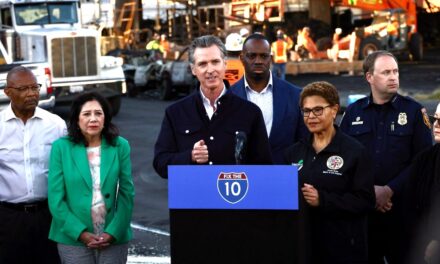
The Donald Trump Presidential Campaign of 2016 is being compared to George Wallace’s 1968 Presidential Campaign. (Photo of George Wallace courtesy of the Wallace Estate, and Donald Trump (Photo Gina Yarbrough/San Diego County News)
By Danny R. Johnson
Washington, DC Bureau Chief
CLEVELAND – When the gavel drops on Monday morning, July 18, in Cleveland’s Quicken Arena to begin the 2016 Republican National Convention, the party will be focused on two objectives: reintroducing Donald John Trump as someone the country could imagine in the Oval Office during dangerous times, and healing the leftover wounds of a brutal primary season.
But despite all the hype, video-tapings of Trump with his children and grandchildren to give the “I am just like all the rest of you” image, consider his image as it stands in stark comparison to the late independent candidate from the 1968 presidential election, former Alabama Governor and Segregationist, George Wallace.
When you look back at the old TV pictures and interviews of Wallace, like Trump, he comes over as a cross between William Faulkner’s Flem Snopes characters and Huey Long. Wallace, like Trump, was an uninspired orator, with a set, almost unvarying speech, he seems intentionally to mangle his syntax and mispronounce words. Yet he was the only presidential candidate in the fall of 1968 who could be called charismatic. Alas, enters Trump who matches the Wallace charisma to the letter.
Consider Trump’s Republican primary campaign. It was perhaps the most amateurishly organized drive that any serious candidate has mounted in modern American history. In many cities, it was impossible to find his campaign headquarters. In others, like Charleston, there were as many as three, each competing for funds and attention. Not one member of his staff has had previous experience in national politics – that is until he hired professional politicians after he secured the “presumptive nominee” title.
Consider George Corley Wallace himself, the dour little Alabama demagogue who had influenced the entire 1968 campaign, defied the two-party system and raised the specter that no one will be elected President in the fall of 1968. Though the odds against him were very long indeed, he could have conceivably became the 37th President of the U.S. “We could be elected,” he said. “It is not an impossible dream.” His defeat in 1968 by Richard Nixon did not stop him from trying again in 1972, despite having been paralyzed from the waist down by an assassin bullet in 1972, he ran again in 1976.
Nine months ago, many of the political pundits and political party insiders brushed off Trump as a “buffoon,” a “celebrity billionaire who wants only attention and brand name recognition.” Former Florida Governor, Jeb Bush, could confidently say of Trump earlier in the primary season: “I don’t think he’s going to be taken seriously.” After surveying the depleted Republican herd, Bush and other Republicans take every opportunity to excoriate Trump as “the apostle of fear and racism.” Many like Conservative talk show host, Glen Beck, were telling us for weeks that Trump had “peaked” and would soon go downhill. Recently, however, he has found cause to attack Trump and the “masses of disillusioned Republicans” directly. “Do you want to make a point, or do you want to make a change?” he asked his radio audience last week. “Do you want a moment’s satisfaction, or do you want to get four years of action?”
Trump secured more than 13 million votes in the GOP primary, more than any Republican candidate this century, or in history. That’s more votes Wallace and General Curtis LeMay, his running mate in 1968 ever got. Fervent Wallace supporters went on to grant Wallace 47 electoral votes which was not enough to stop Nixon from winning the presidency.
Trump Banking on Smoldering Distrust/Fear Among the Electorates
As in 1964, when he made his first presidential bid but dropped out of the race after Barry Goldwater was nominated, support for Wallace’s American Independent Party was concentrated in the South, where Gallup gave him 38% of the vote, more than he gave either Nixon or U.S. Senator Hubert Humphrey (D-MN). But strong Wallace sentiment was found in every other section as well. He was on the ballot in all 50 states. Forums in Milwaukee and Grand Rapids were “Standing Room Only” when the former Governor appeared, and large crowds turned out for motorcades in such Northern strongholds as Chicago and Jersey City. About 20,000 ignored chill weather to hear the standard Wallace spiel on Boston’s historic Commons, which once was as far from Dixie in attitude as the other side of the galaxy. “They were really packed in there together,” Wallace exuberantly told reporters. The other two candidates “would be proud to draw such a crowd.”
All the Republican primary contenders would have been even prouder to evoke the empathy and enthusiasm that Trump so often aroused. Like Wallace, Trump, the celebrity billionaire and TV star, was the only contender left who attracted such spontaneous support. Just as antiwar sentiments of the late 1960s found expression in U.S. Senator Eugene McCarthy, said Historian James MacGregor Burns, “the smoldering distrust among urban whites” found its voice in Wallace.”
At the big Buick factory in Flint in the summer of 1968, a poll of 8,000 members of United Auto Workers Local 599 showed that 49% would vote for Wallace, 39% for Humphrey, 12% for Nixon. Alarmed, labor leadership had quietly dropped its usual pre-election drive to register all union members, and in concentrating instead on African American neighborhoods, where Humphrey can count on solid, if unenthusiastic support. The A.F.L.-C.I.O.’s Committee on Political Education (COPE) had distributed thousands of pamphlets documenting Wallace’s consistent anti-labor record in Alabama. Few members seem to read them or note that COPE rated the Vice President a 100% supporter of labor when he was in the Senate.
Trump Hopes to Duplicate Wallace’s National Strategy
Trump frequently lashes out at the U.S. Chamber of Commerce’s scathing criticism of his stance on trade, highlighting divisions within the Republican Party that threaten unity ahead of the Nov. 8 election. At a recent campaign rally in Maine, Trump called the nation’s largest business association “controlled totally by various groups of people who don’t care about you whatsoever.” He said new trade deals should be negotiated because foreign countries are taking advantage of America.
Trump appears to be capitalizing on the blue collar workers’ discontent with trade deals which they perceive as creating the loss of manufacturing jobs. Blue-collar workers made up a large proportion of Wallace’s supporters, and the same is for Trump, who has a special hold on the less educated and the less affluent. Here are a couple of issues resonating well with blue collar white voters:
• Trump attracts the white union member who fears for his seniority and job going overseas;
• The white homeowner who is afraid that immigrants and minorities will lower property values in their neighborhood;
• He voices the unease of white southern and mid-west families who do not want to see their children forced to accept same sex marriage and transgender rights;
• Voices the fears of middle-aged whites who are outraged by urban protest and the constant threats proposed by ISIL extremists; and
• Illegal immigrants who take advantage of the welfare programs simply because they are newly arrived immigrants.
Often the Wallace supporter, typically a central-city resident, felt that he was not understood by the suburbanite who does not have to worry about racial violence and crime in the streets. Indeed, many in the Wallace constituency had eminently reasonable complaints, even if they were not always recognized by liberals or the policymakers in Washington that Wallace derided. The lower middle class was hurt by crime, high taxes, inflation and the other ills of the 1960s. It could not comprehend why, and had a sinking feeling that its world was falling apart.
The Donald Trump “Make America Great Again’ echoes the same concerns of white suburbanites and rural whites as Wallace did in 1968.
There are many reasons for Trump’s appeal, but his antipathy to “them”–anybody who is not “us”–is the chief one. While Trump stoutly denies that he is a racist, “they” usually means the blacks. “They” also embraces Supreme Court Justices and bureaucrats in Washington, professors in colleges, and journalists almost anywhere. Trump supporters feel that “they” have all taken too much control over their lives. In a curious way, the roots of the Trump movement are entangled with those of the Progressive Movement. Both would welcome drastic change in institutions that seem aloof and unresponsive to their needs.
With a histrionic flair for the crude, sardonic image, Trump lampoons all of “them,” assuring his listeners that they themselves are just as smart as the people in positions of power. The bureaucrats who enforce trade deal guidelines “don’t have enough sense to know how to get out of bed in the morning, so they have to write a guideline for us.” Intellectuals are “overeducated, ivory-tower folk,” or “pointy-headed professors who can’t even park a bicycle straight.” He says: “Any truck driver would know right off what to do at the scene of an accident, but you take a college professor, he’d just stand around lookin’ and gettin’ sick.”
Few in Trump’s audiences believe what they read in the nation’s newspapers, TV, Internet or magazines. Though he is usually amiable with newsmen in private if they are on good terms with him of course, Trump nurtures this general distrust by deriding reporters and editors as “stupid intellectual morons.” When he does come up against the “pointy heads,” it is almost always the common man who triumphs over the products of Cambridge, Berkeley or New Haven. Usually more adroit than his questioners, Trump either evades tough questions or answers them with a half-truth about his record as a businessman.
Some scholars compared George Wallace’s movement to Nazism and Fascism. German-born Professor Hans Morgenthau, perhaps extrapolating from his own country’s unhappy past, identified the Hitler and Wallace movements as representing “the revolt of the lower middle classes against the modern age.” C. J. Burnett, a former political scientist at the University of Pennsylvania, explained the third-party leader in two words: “Adolf Wallace.” Such comparisons are as simplistic and misleading as anything George Wallace himself has hurled at his opponents. The Wallace phenomenon was disquieting enough in its own terms: it does not have to be equated with a political horror that arose in totally different ways and under totally different circumstances.
The Alabamian himself grew furious at the Hitler parallel, reminding his younger critics at the time that “I was fighting Nazis before you were born.” Which is, of course, true. Social Critic Michael Harrington wrote that he would not call Wallace a fascist, but believes that his movement was one of the closest things to Fascism this country had ever known. “Society has certainly become worse when it is legitimate to voice racist thoughts,” said Harrington.
In large measure, Donald Trump is, as former Harvard Psychiatrist Robert Coles said (quoting Tolstoy) about Wallace, the product of a “series of accidents, a coming together of various events.” The war in Vietnam was one of the chief accidents just as the Iraq War and the ISIL threats, acting as a catalyst for many others. Wallace supporters–like many other voters—could not comprehend why the U.S. could not whip the North Vietnamese, and they felt aggrieved at the burden the war had placed on their pocketbooks.
Trump echoes the same sentiments regarding the nation’s “unnecessary rush to go to war in Iraq.” And the trillions of dollars the nation has spent on a war that knows no end.
Indeed, many of the people who have flocked to Trump are so disenchanted with normal politics that they may never be brought back. In a weird doppelganger effect, they mirror the radicals of the left–who may, in time, find their own party and their own Trump in which Bernie Sanders tried to fulfill. The genius of the American political system has been that, unlike those of Europe, it has kept right and left from polarizing into separate, warring parties. This may no longer be true. “We might well end up with a multiparty system,” warned the late Republican U.S. Senator Barry Goldwater, a Nixon supporter in 1968. Goldwater predicted: “Given our present Constitution, this could mean disaster for America.”
Toward that end, some Republicans warn that substance should not get lost amid the made-for-television spectacle in Cleveland’s Quicken Arena. American voters are faced with a perplexing choice for Election 2016: Vote on your fears and frustrations or come together as a nation and vote for the future where everybody is included as part of the American experiment. Until American voters come together and unify under one common interest and shared destiny instead of divisions and distrust of each other, the Donald Trumps, political institutions and Super PACs will continue to fleece and exploit our fears and prejudices for their satisfaction and personal gain.








